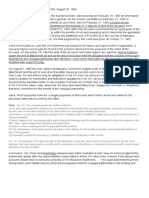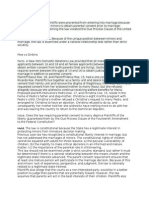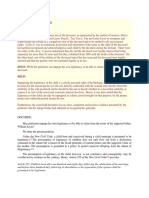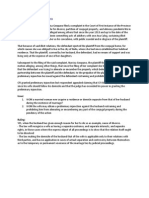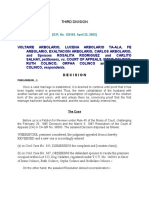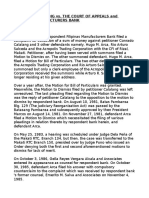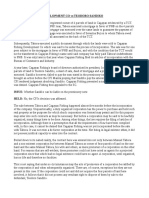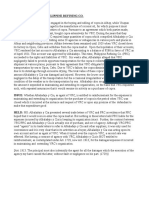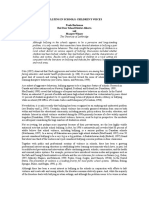Arbolario V CA (Digest)
Arbolario V CA (Digest)
Uploaded by
Liaa AquinoCopyright:
Available Formats
Arbolario V CA (Digest)
Arbolario V CA (Digest)
Uploaded by
Liaa AquinoOriginal Description:
Original Title
Copyright
Available Formats
Share this document
Did you find this document useful?
Is this content inappropriate?
Copyright:
Available Formats
Arbolario V CA (Digest)
Arbolario V CA (Digest)
Uploaded by
Liaa AquinoCopyright:
Available Formats
ARBOLARIO v CA (G.R. No. 129163; April 22, 2003; J.
Panganiban) FACTS: The original owners of the controverted lot, spouses Anselmo Baloyo and Macaria Lirazan, had 5 children. Everyone mentioned is dead. The first child, Agueda Colinco, was survived by her two children, namely, Antonio Colinco and Irene Colinco (respondent); Antonio Colinco predeceased his three daughters, respondents Ruth, Orpha, and Goldelina, all surnamed Colinco. The second child, Catalina Baloyo, was married to Juan Arbolario and their union was blessed with the birth of only one child, Purificacion Arbolario, who, in 1985, died a spinster and without issue. Juan Arbolario, consorted with another woman by the name of Francisca Malvas and from this cohabitation petitioners Voltaire Arbolario, Lucena Arbolario Taala, Fe Arbolario, Exaltacion Arbolario, and Carlos Arbolario (referred to hereinafter as Arbolarios) were born. All the foregoing petitioners were born well before the year 1951. In 1946, the third child, Eduardo Baloyo, sold his entire interest in the lot to his sister, Agueda (first child), by virtue of a notarized document. In 1951, a notarized declaration of heirship was executed by and between Agueda, Catalina, Gaudencia, and their brothers Eduardo and Julian, who extrajudicially declared themselves to be the only heirs of the late spouses Anselmo Baloyo and Macaria Lirazan. The fourth child, Gaudencia Baloyo, conveyed her interest in the said lot in favor of her two nieces, Irene Colinco to one-half (1/2) and Purificacion Arbolario to the other half. Purificacion Arbolario was then allowed to take possession of a portion of the disputed parcel until her death sometime in 1984 or 1985. Respondents Irene Colinco, Ruth Colinco, Orpha Colinco, and Goldelina Colinco, believing themselves to be the only surviving heirs of Anselmo Baloyo and Macaria Lirazan, executed a Declaration of Heirship and Partition Agreement, dated May 8, 1987 where they adjudicated upon themselves their proportionate or ideal shares: Irene Colinco, to one-half (1/2); while the surviving daughters of her (Irenes) late brother Antonio, namely Ruth, Orpha, and Goldelina Colinco, to share in equal, ideal proportions to the remaining half (1/2). On October 2, 1987, the Colincos filed a case against Spouses Rosalita Rodriguez Salhay and Carlito Salhay, seeking to recover possession of a portion of the aforesaid lot occupied by respondent spouses (Salhays hereinafter) since 1970. The Salhays alleged in their defense that they have been the lawful lessees of the late Purificacion Arbolario since 1971 up to 1978; and that said spouses allegedly purchased the disputed portion of Lot from the deceased lessor sometime in September 1978. On May 9, 1988 before the case was tried the Arbolarios and spouses Carlito Salhay and Rosalita Rodriguez Salhay (all respondents in the case) filed another case [f]or Cancellation of Title with Damages. The Arbolarios, joined by the Salhays, contend that the Declaration of Heirship and Partition Agreement executed by the Colincos was defective and thus voidable as they (Arbolarios) were excluded therein. The Arbolarios claim that they succeeded intestate to the inheritance of their alleged half-sister, Purificacion Arbolario; and, as forced heirs, they should be included in the distribution of the aforesaid lot. (Relevant) ISSUE: (1) WoN Arbolarios are illegitimate children HELD: (1) YES, they are illegitimate.** There is no solid basis for the argument of petitioners that Juan Arbolarios marriage to Francisca Malvas was valid. It does not follow that just because his first wife has died, a man is already conclusively married to the woman who bore his children. A marriage certificate or other generally accepted proof is necessary to establish the marriage as an undisputable fact. Since they failed to prove the fact (or even the presumption) of marriage between their parents, Juan Arbolario and Francisca Malvas; hence, they cannot invoke a presumption of legitimacy in their favor. Paternity or filiation, or the lack of it, is a relationship that must be judicially established.
NOTES: LOWER COURT RULINGS: o RTC: Arbolarios were the brothers and the sisters of the deceased Purificacion Arbolario, while the Colincos were her cousins and nieces. The Colincos could not inherit from her, because she had half-brothers and half-sisters (CC, Article 1009). Their 1987 Declaration of Heirship and Partition Agreement was made in bad faith, because they knew all along the existence of, and their relationship with, the Arbolarios. The Salhays, on the other hand, had no document to prove their acquisition and possession of a portion of the disputed lot. o CA: Arbolarios are illegitimate. Illegitimate children are barred by Article 992 of the Civil Code from inheriting intestate from the legitimate children and relatives of their father or mother. As the illegitimate siblings of the late Purificacion Arbolario, petitioners cannot conveniently undermine the legal limitations by insisting that they were treated as half-brothers and half-sisters by the deceased. **(other reasons for illegitimacy, seemed less important): A review of the 1951 Declaration reveals that the year of Catalinas death was intercalated. The first two numbers (1 and 9) and the last digit (3) are legible; but the third digit has been written over to make it look like a 0. Further, the paragraph quoted by petitioners should show a chronological progression in the heirs years of death: Agueda died in 1940 and Eduardo in 1947. Hence, if Catalina had indeed died in 1903, why then was her name written after Aguedas and not before it? Moreover, the document, being in Spanish, requires an of ficial translation. We cannot readily accept the English translation proffered by petitioners, since respondents did not agree to its correctness. Besides, it consisted of only a paragraph of the whole document. OTHER ISSUES IN THE CASE: o WoN CA committed a serious error when it disregarded the testimony that the Salhays had purchased the portion of the lot they had been occupying since 1970; SC says NO, though the sale was not expressly assigned as an error in their Brief, respondents (as petitioners in the CA) still assailed the existence of the sale o WoN CA overstepped its bounds when it ruled that since respondents did not raise the issue of partition on appeal, the RTC had no jurisdiction to divide the disputed lot; SC says NO, the purpose of partition is to put an end to co-ownership. It seeks a severance of the individual interests of coowners, vesting in each of them a sole estate in a specific property and a right to enjoy the allotted estate without supervision or interference.
You might also like
- Valino vs. Adriano (Digest)Document2 pagesValino vs. Adriano (Digest)Tini Guanio100% (4)
- Bowenian Family TherapyDocument7 pagesBowenian Family TherapyCybill BlakeNo ratings yet
- Arriola vs. Arriola CD - PersonsDocument2 pagesArriola vs. Arriola CD - PersonsLisa Marie J. Clemente100% (2)
- PENA Vs CADocument2 pagesPENA Vs CALiaa Aquino100% (1)
- Genogram ReflectionDocument8 pagesGenogram Reflectionapi-316418035100% (3)
- 10) Arbolario vs. CA, GR No. 129163, 22 April 2003Document2 pages10) Arbolario vs. CA, GR No. 129163, 22 April 2003Pio Guieb Aguilar100% (1)
- Arbolario V CA - DigestDocument2 pagesArbolario V CA - DigestAgz MacalaladNo ratings yet
- Baldos v. Court of Appeals PDFDocument3 pagesBaldos v. Court of Appeals PDFerxha lado100% (1)
- Salas JR Vs AguilaDocument2 pagesSalas JR Vs AguilaShimi FortunaNo ratings yet
- People V Lagrimas DigestDocument4 pagesPeople V Lagrimas DigestAliw del RosarioNo ratings yet
- People of The Philippines v. Marlon Barsaga AbellaDocument1 pagePeople of The Philippines v. Marlon Barsaga AbellaMarie ChieloNo ratings yet
- 227 - Luna vs. IACDocument3 pages227 - Luna vs. IACNec Salise ZabatNo ratings yet
- Hiyas Savings Vs AcunaDocument1 pageHiyas Savings Vs AcunaJohn Fredrick BucuNo ratings yet
- Anaya Vs PalaroanDocument2 pagesAnaya Vs PalaroanLouise Bolivar Dadivas100% (1)
- Jacinto Saguid Vs CADocument2 pagesJacinto Saguid Vs CAChristianneDominiqueGravoso100% (3)
- Moe Vs DinkinsDocument3 pagesMoe Vs Dinkinsanon_337583363No ratings yet
- Dela Pena V Avila - PFRS Conjugal PropertyDocument2 pagesDela Pena V Avila - PFRS Conjugal PropertyMichael Lamson Ortiz Luis100% (1)
- Ansaldo V SheriffDocument1 pageAnsaldo V SheriffMiggy Cardenas100% (1)
- Alinas Vs AlinasDocument1 pageAlinas Vs AlinasPat GarciaNo ratings yet
- Ferrer v. FerrerDocument2 pagesFerrer v. FerrerArdenNo ratings yet
- 372 PEOPLE v. GERSAMIODocument1 page372 PEOPLE v. GERSAMIOEmmanuel Alejandro YrreverreIiiNo ratings yet
- PERSONS - ALINAS V ALINAS - GR.158040Document2 pagesPERSONS - ALINAS V ALINAS - GR.158040Cedric KhoNo ratings yet
- MORENO V BernabeDocument2 pagesMORENO V BernabeFina SchuckNo ratings yet
- DE CASTRO Vs ASSIDAO-DE CASTRODocument2 pagesDE CASTRO Vs ASSIDAO-DE CASTROMariam PetillaNo ratings yet
- 15.1 Liyao Vs Tanhoti-Liyao DigestDocument2 pages15.1 Liyao Vs Tanhoti-Liyao DigestEstel TabumfamaNo ratings yet
- Sanchez V ZuluetaDocument1 pageSanchez V ZuluetaZarah JeanineNo ratings yet
- Jones v. Hortiguela (1937)Document2 pagesJones v. Hortiguela (1937)Andre Philippe Ramos100% (1)
- Digest Mendoza Vs RepublicDocument1 pageDigest Mendoza Vs RepublicMico Maagma CarpioNo ratings yet
- 08 Munoz V RamirezDocument2 pages08 Munoz V Ramirezpdasilva100% (1)
- So v. Valera, G.R. No. 150677, June 5, 2009Document2 pagesSo v. Valera, G.R. No. 150677, June 5, 2009MonicaCelineCaro100% (2)
- Liyao Jr. v. Tanhoti Liyao - TAN 4DDocument3 pagesLiyao Jr. v. Tanhoti Liyao - TAN 4DVince Llamazares LupangoNo ratings yet
- Cacho V People Digest 1Document2 pagesCacho V People Digest 1Onireblabas Yor OsicranNo ratings yet
- Persons (Veloso Vs Martinez)Document14 pagesPersons (Veloso Vs Martinez)Faye Cience Bohol100% (2)
- Salazar V FeliasDocument2 pagesSalazar V FeliasAngeliNo ratings yet
- Mendoza Vs CA 201 Scra 675Document9 pagesMendoza Vs CA 201 Scra 675Reuben EscarlanNo ratings yet
- Abunado v. PeopleDocument3 pagesAbunado v. PeopleJaidee SanchezNo ratings yet
- Go-Bangayan v. BangayanDocument3 pagesGo-Bangayan v. BangayanSand Fajutag100% (1)
- Romero V SingsonDocument1 pageRomero V SingsonAngeliNo ratings yet
- LEONILA G. SANTIAGO, Petitioner, vs. Peopleof The Philippines, RespondentDocument10 pagesLEONILA G. SANTIAGO, Petitioner, vs. Peopleof The Philippines, RespondentKristelle IgnacioNo ratings yet
- DOCENA VS Lapesura DigestDocument2 pagesDOCENA VS Lapesura Digestproject_ziNo ratings yet
- Republic Vs GranadaDocument2 pagesRepublic Vs GranadaAljenneth MicallerNo ratings yet
- Quiao v. QuiaoDocument3 pagesQuiao v. QuiaoCarla Mae MartinezNo ratings yet
- Unson Vs NavarroDocument2 pagesUnson Vs NavarroLynne Agapito100% (2)
- Facts:: G.R. No. L-27939 October 30, 1928 Fortunata Solis vs. Maxima Barroso, Et AlDocument1 pageFacts:: G.R. No. L-27939 October 30, 1928 Fortunata Solis vs. Maxima Barroso, Et AlLei Jeus Taligatos0% (1)
- De La Viña V VillarealDocument1 pageDe La Viña V VillarealEumell Alexis PaleNo ratings yet
- Keuppers v. MurciaDocument2 pagesKeuppers v. MurciaAna AplascaNo ratings yet
- PNB vs. Reyes - Annulment of REMDocument2 pagesPNB vs. Reyes - Annulment of REMTheodore0176100% (1)
- Costuna v. DomondonDocument2 pagesCostuna v. DomondonDominic GloriaNo ratings yet
- Laperal v. KatigbakDocument1 pageLaperal v. KatigbakCrizziaNo ratings yet
- Persons - Docena v. Lapesura (Property Relations) GR 140153Document2 pagesPersons - Docena v. Lapesura (Property Relations) GR 140153Jeffrey Endrinal100% (1)
- Carlos Vs AbelardoDocument1 pageCarlos Vs Abelardoneo paul100% (1)
- 1 Jones vs. HortiguelaDocument1 page1 Jones vs. HortiguelaSimon James SemillaNo ratings yet
- Sarmiento V IacDocument5 pagesSarmiento V IacangelaNo ratings yet
- Tambuyat V TambuyatDocument1 pageTambuyat V TambuyatMigs GayaresNo ratings yet
- LR de Aparicio vs. ParaguyaDocument2 pagesLR de Aparicio vs. ParaguyaMonica B. AsebuqueNo ratings yet
- Remo vs. Secretary of Foreign Affairs, G.R. No. 169202, March 5, 2010Document2 pagesRemo vs. Secretary of Foreign Affairs, G.R. No. 169202, March 5, 2010Lu Cas100% (1)
- Valdez V Dabon PDFDocument2 pagesValdez V Dabon PDFJohn Anthony B. LimNo ratings yet
- Zoleta-San Agustin v. Sales (Digest)Document2 pagesZoleta-San Agustin v. Sales (Digest)Hannah Plamiano TomeNo ratings yet
- Laperal-vs-KatigbakDocument1 pageLaperal-vs-KatigbakLei Jeus TaligatosNo ratings yet
- Arbolario V CaDocument6 pagesArbolario V CaLouis MalaybalayNo ratings yet
- Legitimate CasesDocument38 pagesLegitimate CasesQueen AlipayoNo ratings yet
- The CaseDocument7 pagesThe CasejeffreyNo ratings yet
- TanDocument6 pagesTanApril Joy AbellanoNo ratings yet
- Sarmiento Vs JuanDocument5 pagesSarmiento Vs JuanLiaa AquinoNo ratings yet
- Conrado Calalang vs. The Court of Appeals and Filipinas Manufacturers BankDocument7 pagesConrado Calalang vs. The Court of Appeals and Filipinas Manufacturers BankLiaa AquinoNo ratings yet
- Civpro Digests Cases 12-17Document17 pagesCivpro Digests Cases 12-17Liaa AquinoNo ratings yet
- Vive Eagle Land, Inc. v. National Home Mortgage Finance Corp PDFDocument5 pagesVive Eagle Land, Inc. v. National Home Mortgage Finance Corp PDFLiaa AquinoNo ratings yet
- Central Cooperation Exchange Vs EncisoDocument3 pagesCentral Cooperation Exchange Vs EncisoLiaa AquinoNo ratings yet
- LCK Vs Planters Development BankDocument5 pagesLCK Vs Planters Development BankLiaa AquinoNo ratings yet
- Indiana Aerospace University vs. ChedDocument4 pagesIndiana Aerospace University vs. ChedLiaa Aquino100% (1)
- Boiser Vs AguirreDocument2 pagesBoiser Vs AguirreLiaa Aquino100% (1)
- ROXAS Vs DE LA ROSADocument1 pageROXAS Vs DE LA ROSALiaa AquinoNo ratings yet
- Singson Vs CoaDocument2 pagesSingson Vs CoaLiaa Aquino50% (2)
- United Pulp and Paper Co., Inc., Vs - United Pulp and Paper Chapter-Federation of Free WorkersDocument2 pagesUnited Pulp and Paper Co., Inc., Vs - United Pulp and Paper Chapter-Federation of Free WorkersLiaa Aquino100% (1)
- Marinduque Mining &industrial Corp. Vs CADocument2 pagesMarinduque Mining &industrial Corp. Vs CALiaa AquinoNo ratings yet
- LEE Vs CADocument2 pagesLEE Vs CALiaa AquinoNo ratings yet
- Ponce Vs EncarnacionDocument1 pagePonce Vs EncarnacionLiaa Aquino100% (1)
- Detective Protective Bureau Inc Vs Hon. CloribelDocument2 pagesDetective Protective Bureau Inc Vs Hon. CloribelLiaa AquinoNo ratings yet
- LDB Vs AldbeDocument1 pageLDB Vs AldbeLiaa AquinoNo ratings yet
- ISA Vs CADocument1 pageISA Vs CALiaa AquinoNo ratings yet
- (Digest 10) Star Paper Corp Vs SimbolDocument3 pages(Digest 10) Star Paper Corp Vs SimbolLiaa AquinoNo ratings yet
- Rizal Light Vs PSCDocument2 pagesRizal Light Vs PSCLiaa Aquino75% (4)
- (Digest) Philippine Education Co. Inc. v. SorianoDocument1 page(Digest) Philippine Education Co. Inc. v. SorianoLiaa AquinoNo ratings yet
- Paguia Vs OP - Cruz Vs Mina - Bulacan Vs TorcinoDocument4 pagesPaguia Vs OP - Cruz Vs Mina - Bulacan Vs TorcinoLiaa AquinoNo ratings yet
- Lanuza Vs CADocument3 pagesLanuza Vs CALiaa Aquino100% (2)
- Cagayan Fishing Development Co Vs Teodoro SandikoDocument1 pageCagayan Fishing Development Co Vs Teodoro SandikoLiaa Aquino100% (2)
- Digest 07 - Palma Vs CristobalDocument2 pagesDigest 07 - Palma Vs CristobalLiaa Aquino0% (1)
- Digest 05 - Albaladejo Vs PRC - OdtDocument1 pageDigest 05 - Albaladejo Vs PRC - OdtLiaa AquinoNo ratings yet
- Digest 01 - Orient Air Services Vs CA - OdtDocument2 pagesDigest 01 - Orient Air Services Vs CA - OdtLiaa AquinoNo ratings yet
- Digest 03 - Air France Vs CADocument1 pageDigest 03 - Air France Vs CALiaa AquinoNo ratings yet
- Review Unit 1Document4 pagesReview Unit 1Nguyễn DuyênNo ratings yet
- CHARACTERISTICS OF THE 14 15 16-ConvertiDocument5 pagesCHARACTERISTICS OF THE 14 15 16-ConvertibassemNo ratings yet
- Types of Heirs: A Āb Al-Farā'i (4 Males & 8 Females)Document4 pagesTypes of Heirs: A Āb Al-Farā'i (4 Males & 8 Females)Yousuf ZafarNo ratings yet
- Helping Children Understand Divorce: Amily ElationsDocument6 pagesHelping Children Understand Divorce: Amily ElationsNaiane WendtNo ratings yet
- Elementary SchoolDocument2 pagesElementary SchoolDaryna KovalevaNo ratings yet
- Botswana PDFDocument42 pagesBotswana PDFJasiz Philipe OmbuguNo ratings yet
- Let's Try This Observation of Other's Uniqueness: Week 2Document7 pagesLet's Try This Observation of Other's Uniqueness: Week 2Ma. QNo ratings yet
- 2022 Yyas Application - SampleDocument21 pages2022 Yyas Application - SampleIvan AdouNo ratings yet
- Case Study: See: Interview QuestionsDocument5 pagesCase Study: See: Interview Questionsapi-284189677No ratings yet
- Fs1 Ep4.Document14 pagesFs1 Ep4.hanap hanapinNo ratings yet
- Impact of Perinatal Death On The Social and Family Context of The ParentsDocument54 pagesImpact of Perinatal Death On The Social and Family Context of The ParentsSri mulyaniNo ratings yet
- Culminating Activity PR 1Document3 pagesCulminating Activity PR 1andrew0% (1)
- Blood & SaltDocument130 pagesBlood & SaltYogo Dagorah33% (3)
- Essay About Children and LifeDocument3 pagesEssay About Children and LifekassandratayabaNo ratings yet
- Home and School Relationship Role To Kindergarten Pupils' Developmental DomainsDocument11 pagesHome and School Relationship Role To Kindergarten Pupils' Developmental DomainsIOER International Multidisciplinary Research Journal ( IIMRJ)No ratings yet
- Family in The CaribbeanDocument22 pagesFamily in The CaribbeanShanta MathaiNo ratings yet
- Rath Yatra 2Document36 pagesRath Yatra 2Fun with bhavyaNo ratings yet
- Quarter 1-Activity 2-Accepting The Individuality of OthersDocument2 pagesQuarter 1-Activity 2-Accepting The Individuality of OthersPoblete RexNo ratings yet
- Lession 1Document6 pagesLession 1trantran200306No ratings yet
- Piyush KhuranaDocument16 pagesPiyush KhuranaVinay SharmaNo ratings yet
- Bullying in SchoolsDocument8 pagesBullying in Schoolssaras qt0% (1)
- BronfenbrennerDocument12 pagesBronfenbrennerfranciscolapridaNo ratings yet
- Rizal Week 2 and 3Document3 pagesRizal Week 2 and 3Mike Dela CruzNo ratings yet
- Status Review Sample Los Angeles DcfsDocument18 pagesStatus Review Sample Los Angeles DcfsSusyBonillaNo ratings yet
- Chapter 5 Answer SheetDocument17 pagesChapter 5 Answer SheetLaurence joy AnchetaNo ratings yet
- Rules of PronounDocument31 pagesRules of PronounRajesh GoladaNo ratings yet
- The Self With OthersDocument61 pagesThe Self With OthersJohnny Ortega Sy Reyes IINo ratings yet
- Adoption in IslamDocument4 pagesAdoption in IslamShahid.Khan1982No ratings yet









